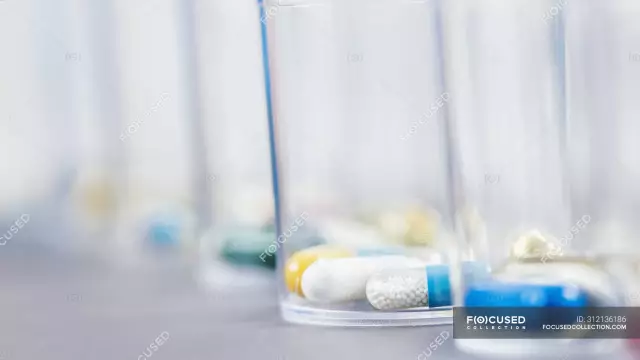- Author Rachel Wainwright [email protected].
- Public 2023-12-15 07:39.
- Last modified 2025-11-02 20:14.
Aprotinin
Aprotinin: instructions for use and reviews
- 1. Release form and composition
- 2. Pharmacological properties
- 3. Indications for use
- 4. Contraindications
- 5. Method of application and dosage
- 6. Side effects
- 7. Overdose
- 8. Special instructions
- 9. Application during pregnancy and lactation
- 10. Use in childhood
- 11. In case of impaired renal function
- 12. For violations of liver function
- 13. Use in the elderly
- 14. Drug interactions
- 15. Analogs
- 16. Terms and conditions of storage
- 17. Terms of dispensing from pharmacies
- 18. Reviews
- 19. Price in pharmacies
Latin name: Aprotinin
ATX code: B02AB01
Active ingredient: Aprotinin (Aprotinin)
Manufacturer: Firm "FERMENT" LLC (Russia); Obninsk Chemical-Pharmaceutical Company CJSC (Russia)
Description and photo update: 2020-28-05

Aprotinin is a hemostatic agent from the group of polyvalent plasma proteinase inhibitors with antifibrinolytic properties.
Release form and composition
Dosage forms of Aprotinin:
- lyophilisate for preparation of a solution for intravenous (iv) administration: lyophilized powder of white or almost white color, complete with a solvent (colorless, transparent liquid), or without [lyophilisate - 10,000 antitrypsin units (ATpE) in a colorless glass vial, sealed with a stopper, aluminum cap and polyethylene lid; solvent (sodium chloride solution 0.9%) - 2 ml each in a colorless glass ampoule; in a cardboard box 1, 2, 3 or 5 bottles; in a blister strip packaging 5 vials with lyophilisate and the corresponding number of ampoules with a solvent, in a cardboard box 1, 2, 3 or 5 packages; in a blister strip packaging 5 vials with lyophilisate and 5 ampoules with a solvent, in a cardboard bundle 1, 2, 3 or 5 packages with vials complete, respectively, with 1, 2, 3 and 5 packages with ampoules or without];
- solution for intravenous administration: clear liquid with a pale yellow or brownish-yellow tint (10 ml each in a colorless glass ampoule with a break point or a break ring; in a blister strip packaging 5 ampoules, in a cardboard box 1, 2 or 5 packs) …
Each pack also contains instructions for the use of Aprotinin.
The composition of the lyophilisate for 1 bottle:
- active substance: aprotinin - 10,000 ATre *;
- additional components: hydrochloric acid 1% qs (to create pH), mannitol.
The composition of the solvent: sodium chloride 0.9%, water for injection.
Composition for 1 ml of solution:
- active substance: aprotinin - 10,000 kallikrein inactivating units (KIE);
- additional components: benzyl alcohol, sodium chloride, water for injection.
* 10,000 ATre is equivalent to 13,300 KIE.
Pharmacological properties
Pharmacodynamics
Aprotinin belongs to inhibitors of proteolytic enzymes of a broad spectrum of action, exhibits hemostatic and antifibrinolytic efficacy. Taking part in the formation of reversible stereometric complexes, enzyme inhibitors, it thereby weakens the activity of tissue and plasma kallikrein, plasmin and trypsin, leading to suppression of fibrinolysis and thrombin synthesis, thus providing a hemostatic effect against the background of coagulopathies. The active ingredient inhibits the contact phase of coagulation activation, initiating hemocoagulation and simultaneously activating fibrinolysis. In the case of using a heart-lung machine (AIC), as a result of blood contact with foreign surfaces, activation of the contact phase of coagulation is often recorded.
Aprotinin weakens the systemic inflammatory response that occurs during surgical interventions using AIC and leads to the interdependent activation of fibrinolysis, the hemostatic system, activation of humoral and cellular reactions.
Due to blocking of the kinin-kallikrein system, Aprotinin can be used for the prevention and treatment of shock of various origins, as well as for angioedema. The agent prevents the release of inflammatory cytokines and reduces the loss of glycoproteins (GP) Ib, IIb, IIIa by platelets and prevents the expression of anti-inflammatory adhesive HP by granulocytes (IIb).
The use of the drug during the period of surgical operations with the use of AIK can reduce the volume of blood loss and the need for blood transfusion.
The available data on the effectiveness of the drug in acute / chronic pancreatitis are rather contradictory; in some studies, its therapeutic effect in pancreatitis has not been established.
The activity of the drug is expressed in KIE, ATpE, as well as in trypsin inactivating units of the European Pharmacopoeia (Ph. Eur. U); 1 ATRE = 1.33 KIE, 1 Ph. Eur. U = 1800 KIE.
Pharmacokinetics
In the course of comparing the pharmacokinetic characteristics of Aprotinin in healthy volunteers, in patients with cardiac pathology under conditions of using AIK or during hysterectomy operations, in the case of receiving doses from 0.5 to 2 million CIU, the linear pharmacokinetics of the drug was established.
After intravenous administration, the active substance is intensively distributed in the extracellular space (the equilibrium volume of distribution is about 20 liters), accumulates for a short time in the kidneys, and to a lesser extent in the cartilage tissue. The rapid distribution of aprotinin is the reason for a significant initial decrease in its concentration in plasma and a short initial half-life (T 1/2) of 0.3-0.7 hours. The final T 1/2 can vary from 5 to 10 hours.
Intraoperative mean equilibrium plasma concentrations for aprotinin are 175-281 CIU / ml when it is used during the operation in the following mode: loading dose IV - 2 mln CIU, primary IV infusion - 2 mln CIU, continuous infusion - each hour throughout the entire period of the operation at a dose of 0.5 million KIU. If in this case half doses are used, the mean equilibrium plasma concentrations are 110-164 CIE / ml.
The drug practically does not pass through the placenta and does not enter the cerebrospinal fluid.
The active substance is metabolized by lysosomal enzymes in the kidneys with the formation of inactive derivatives - short peptide chains and amino acids. For 48 hours, 25 to 40% are excreted in the urine as inactive metabolites. Active aprotinin is found in urine in small amounts - less than 5% of the dose received.
Indications for use
The action of Aprotinin is used in the treatment of the following pathologies:
- intraoperative blood loss and a decrease in the volume of blood transfusion during coronary artery bypass grafting (CABG) operations with the use of AIC - for prevention purposes;
- bleeding caused by hyperfibrinolytic disorders of hemostasis, including post-traumatic and postoperative, before, after and during childbirth; hemorrhagic complications of thrombolytic therapy.
Contraindications
Absolute:
- hypocoagulation against the background of disseminated intravascular coagulation syndrome (DIC syndrome);
- age up to 18 years;
- I and III trimesters of pregnancy;
- hypersensitivity to aprotinin (including the presence of antibodies to cattle proteins - IgG) and any of the additional components.
Relative (use the drug with extreme caution):
- the use of aprotinin over the past 12 months;
- history of hypersensitivity reactions (including to bovine protein);
- combined operations of CABG and other surgical interventions on the heart (the risk / benefit ratio has not been established);
- surgical interventions against the background of circulatory arrest, deep hypothermia;
- the use of centrally acting muscle relaxants for 2-3 days before the proposed administration of aprotinin (the threat of thrombosis of small peripheral vessels).
Aprotinin, instructions for use: method and dosage
Aprotinin, obtained from the lyophilisate and ready-made solution, is injected intravenously slowly, in a stream or drip.
15 minutes before using the drug in order to prevent the appearance of allergic reactions, blockers of H 1 -histamine receptors can be used. In all circumstances, it is necessary to ensure the possibility of implementing urgent standard measures for the treatment of allergic / anaphylactic reactions.
Before prescribing the drug, each patient is recommended to test for the presence of antibodies (IgG) to it. The prescribed dose should be administered only in the absence of an allergic reaction.
To prepare a solution from a lyophilisate, the drug contained in 1 vial should be diluted with a solution of sodium chloride 9% (with the supplied solvent) in a dose of 2 ml. If undissolved particles are present in the finished or obtained solution, or it is visually opaque, the drug cannot be used. With subsequent injections, it is prohibited to inject the remains of the unused solution - they must be disposed of.
Received from the lyophilisate and the finished solution must be injected into the vein slowly, at a rate of 2-3 ml / min. The maximum speed should not exceed 5-10 ml / min. During the administration of the solution, the patient must be in a horizontal position - lying on his back. Aprotinin should be infused through the main veins, not using the latter for the simultaneous administration of other drugs.
It is recommended to use the drug at an initial dose of 751 880-1 503 760 ATpE (1-2 million CIU), injecting IV slowly over 15-20 minutes after the onset of anesthesia and before sternotomy. The next similar dose (751 880-1 503 760 ATpE) must be added to the primary volume of the heart-lungs AIC.
In order to achieve sufficient dilution and prevent its interaction with heparin, add the solution to the primary volume during the recirculation period. After the completion of the bolus injection and until the end of the operation, a continuous infusion should be established at a rate of 187,970-375,940 ATre (250-500 thousand KIU) per hour. The course dose of the drug should not exceed 5,263,158 ATre (7 million CIU).
Against the background of hemostasis disorders before childbirth, during delivery and in the postpartum period, the solution is recommended to be administered at an initial dose of 931 thousand KIE, and then - every hour before stopping bleeding at 186.2 thousand KIE.
Side effects
The use of Aprotinin can cause the following side effects on the part of systems and organs:
- immune system: rarely - allergic, anaphylactoid and anaphylactic reactions; extremely rarely - anaphylactic shock, which is a potential danger to life;
- blood and lymphatic system: extremely rare - coagulopathy, disseminated intravascular coagulation syndrome;
- kidneys and urinary tract: infrequently - impaired renal function, including oliguria, tubular necrosis, acute renal failure;
- cardiovascular system: infrequently - thrombosis, pericardial effusion, thrombosis / occlusion of coronary arteries, myocardial ischemia, myocardial infarction; rarely - arterial thrombosis (possible manifestation of impaired function of the lungs, kidneys, brain); extremely rare - pulmonary embolism;
- others (for lyophilisate): rarely - significant sweating, myalgia, bronchospasm, an increase in serum creatinine;
- general disorders and local reactions: extremely rarely - thrombophlebitis, reactions at the injection / infusion site.
In individuals who are prescribed Aprotinin for the first time, the occurrence of allergic / anaphylactic reactions is unlikely. In the case of repeated use of the drug, especially when administered over the next 6 months, the incidence of adverse events from the immune system can increase up to 5%. When the drug is prescribed 6 months after the first administration, the probability of developing these side effects is 0.9%. If Aprotinin has been used more than 2 times within 6 months, the risk of serious allergic / anaphylactic reactions is exacerbated.
If, upon repeated use of the agent, no symptoms of allergic reactions were recorded, in the case of the subsequent administration of the solution, there is still a threat of severe allergic reactions or anaphylactic shock (including fatal). There have been reports of the development of anaphylactic shock during repeated administration of the drug after more than 12 months after the first use. Symptoms of allergic / anaphylactic reactions may include the following disorders: rash, itching, urticaria, nausea, hypotension, asthma, bronchospasm, with an unknown frequency - psychotic reactions, confusion, hallucinations.
If hypersensitivity reactions occur during the period of use of the drug, it is necessary to immediately stop the administration of the solution and conduct appropriate treatment.
Overdose
Cases of overdose of aprotinin have not yet been recorded.
The specific antidote for the drug is currently unknown.
special instructions
Aprotinin is not a heparin substitute.
The drug can provoke a functional impairment of the kidneys, especially if there is a history of such pathologies. The simultaneous use of Aprotinin with potentially nephrotoxic agents (including aminoglycosides) exacerbates the risk of these side effects.
It is allowed to carry out therapy for hyperfibrinolysis and disseminated intravascular coagulation only after stopping all manifestations of the latter, only against the background of prophylactic use of heparin.
Due to the risk of allergic / anaphylactic reactions, a thorough assessment of the benefit / risk ratio must be made before the solution is administered (especially when reused). 10 minutes before using the main dose of the drug, it is required to enter a trial dose - 10 thousand KIE. However, even if after this test, undesirable effects were not recorded, they may appear when using a therapeutic dose. With the development of hypersensitivity reactions, the administration of aprotinin should be stopped immediately and standard urgent measures should be taken, including intravenous administration of plasma substitutes, prednisolone at a dose of 250-1000 mg, and adrenaline at a dose of 0.05-0.1 mg.
Before treatment, you need to conduct a test to detect antibodies to Aprotinin (IgG). Since patients with antibodies of this class have an increased risk of allergic reactions, when they are detected, the administration of the drug is contraindicated. If the test is impossible, and the likelihood of therapy with other aprotinin drugs over the past 12 months is not excluded, the administration of the solution is also contraindicated.
During the period of surgical intervention on the thoracic aorta with the use of AIC and deep cold cardioplegia, it is necessary to carry out drug therapy with extreme caution against the background of adequate use of heparin. Since the establishment of the activated clotting time is not a standardized test to determine the coagulation capacity of blood, the use of aprotinin can influence various methods of this analysis. The test for measuring the degree of coagulation (AST) with zeolite in the presence of aprotinin increases to a greater extent than the AST test with kaolin. Due to the differences in the protocols, it is recommended, if the drug is available, to take the minimum values of the AST test - 750 sec and the AST test with kaolin - 480 sec.
Applied before the canalization of the heart, as well as added to the primary volume in the AIC, the standard dose of heparin should not be lower than 350 international units per 1 kg of body weight (IU / kg). The additional dose of heparin is determined taking into account body weight and the duration of the period of extracorporeal circulation. Since aprotinin does not affect the protamine titration method, additional doses of heparin are determined in accordance with its concentration calculated by this method. During bypass surgery, the level of heparin should not be below 2.7 units of action (U) / ml (0.2 mg / kg) or fall below the level established before using aprotinin. In the case of using the latter, neutralization of heparin with protamine is required only after interruption of extracorporeal circulation,based on a fixed volume of injected heparin or under the control of the protamine titration method.
The solution contains benzyl alcohol, the daily dose of which should not exceed 90 mg / kg.
Influence on the ability to drive vehicles and complex mechanisms
After the introduction of Aprotinin, care must be taken when driving vehicles and working with complex mechanisms due to the possible occurrence of side effects from the nervous system (including confusion).
Application during pregnancy and lactation
Treatment with Aprotinin in the first and third trimester of pregnancy is contraindicated. In the second trimester, the use of the agent is allowed only if the expected benefit to the mother significantly exceeds the possible threat to the fetus. When assessing the benefit / risk ratio, it is necessary to take into account the negative impact on the fetus of the expressed side effects that are possible during therapy (including anaphylactic reactions and cardiac arrest), as well as the measures taken to eliminate these effects.
The use of the drug during lactation has not been studied. The substance is not absorbed from the gastrointestinal tract (GIT) and, as a result, when Aprotinin is excreted in breast milk, it is considered potentially safe for the child.
The effect of the drug on fertility has not been studied.
Pediatric use
The drug is not prescribed to persons under 18 years of age, since there is no data on the safety and effectiveness of Aprotinin in this age group.
With impaired renal function
In the presence of impaired renal function, changes in the parameters of the pharmacokinetics of Aprotinin were not detected, therefore, there is no need to correct the dosage regimen.
In patients with end-stage renal failure, the pharmacokinetics of the drug have not been studied.
For violations of liver function
There are no data on the basis of which it is required to adjust the dosage regimen in patients with impaired liver function.
Use in the elderly
Elderly patients should not change the dosage regimen of the drug Aprotinin.
Drug interactions
The preparation was found to be compatible with HES (hydroxyethylated starch) solution, 20% glucose solution, Ringer's lactate solution. Do not mix the drug with other medicinal solutions.
Aprotinin dose-dependently inhibits the activity of urokinase and streptokinase.
You should not combine the drug with other drugs, especially beta-lactam antibiotics, adrenal cortex hormones, heparin.
Aprotinin can inhibit the activity of nonspecific serum cholinesterase.
With the combined use of Aprotinin with suxamethonium chloride, the risk of prolonging the period of apnea is aggravated.
Analogs
The analogues of Aprotinin are Aprotex, Ingitril, Trasilol, Kontrikal, Vero-Narkap, Gordox.
Terms and conditions of storage
Store out of the reach of children, protected from light, at a temperature not exceeding 25 ° C, without freezing.
The shelf life of the drug is 3 years, the solvent is 5 years.
Terms of dispensing from pharmacies
Dispensed by prescription.
Reviews about Aprotinin
According to extremely rare reviews of Aprotinin, which are found on specialized sites, the drug has proven itself well in the treatment of bleeding, including postoperative and post-traumatic, as well as shock of various origins.
There are no complaints about the development of adverse events.
Price for Aprotinin in pharmacies
The reliable price for Aprotinin is unknown, since the drug is currently not available in the pharmacy chain.
The cost of the analogue, the drug Aprotex, in the form of a lyophilisate for the preparation of a solution for intravenous administration (100,000 ATRE), can be 700 rubles. for 10 bottles.

Maria Kulkes Medical journalist About the author
Education: First Moscow State Medical University named after I. M. Sechenov, specialty "General Medicine".
Information about the drug is generalized, provided for informational purposes only and does not replace the official instructions. Self-medication is hazardous to health!






